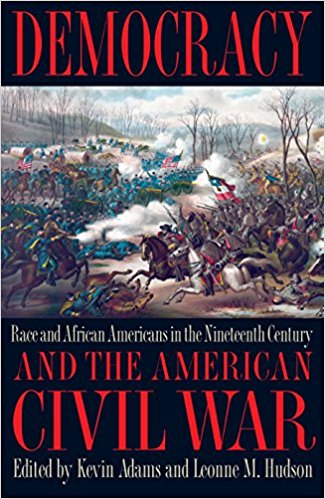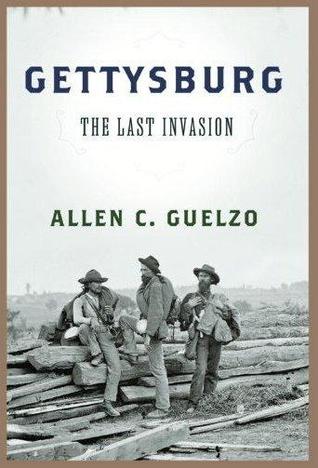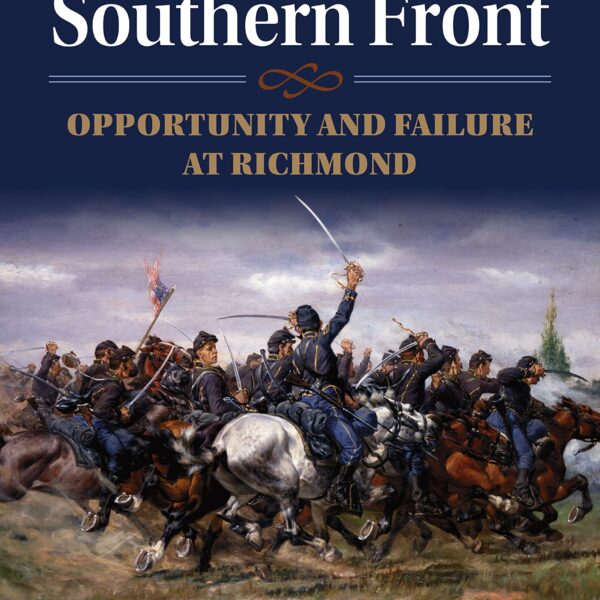Democracy and the American Civil War: Race and African Americans in the Nineteenth Century edited by Kevin Adams and Leonne M. Hudson. Kent State University Press, 2016. Paper, IBSN: 978-1606352694. $24.95.
 The title of this volume is so broad that it is difficult to locate in the vast literature on race and the Civil War; its contents do not make categorization easier. The contributors’ scope spans the long nineteenth century and touches on topics as diverse as Dunning School politics, the U.S. Colored Troops, the Colfax Massacre, the Cherokee judiciary, and populism. Feeling a bit like odds and ends, the essays nevertheless press several vital questions in the scholarship on racism and race in the Civil War era. Presented as a collection on “the unifying themes of democracy and race during and after the Civil War,” the included essays “remind us of the historical importance of democracy and the complexity of issues of race during the nineteenth century and beyond” (2). The notion that democracy is important and race is complicated is not especially innovative, but the volume’s entries raise provocative questions about abolitionists in historical memory, black and Native American identity, the role of the U.S. army in civil rights enforcement, and class identity among Gilded Age White Leaguers.
The title of this volume is so broad that it is difficult to locate in the vast literature on race and the Civil War; its contents do not make categorization easier. The contributors’ scope spans the long nineteenth century and touches on topics as diverse as Dunning School politics, the U.S. Colored Troops, the Colfax Massacre, the Cherokee judiciary, and populism. Feeling a bit like odds and ends, the essays nevertheless press several vital questions in the scholarship on racism and race in the Civil War era. Presented as a collection on “the unifying themes of democracy and race during and after the Civil War,” the included essays “remind us of the historical importance of democracy and the complexity of issues of race during the nineteenth century and beyond” (2). The notion that democracy is important and race is complicated is not especially innovative, but the volume’s entries raise provocative questions about abolitionists in historical memory, black and Native American identity, the role of the U.S. army in civil rights enforcement, and class identity among Gilded Age White Leaguers.
Reevaluation of settled thinking is the unifying idea in Democracy and the American Civil War. The key essay is Stanley Harrold’s review of historical assessments of abolitionists. Though abolitionists are generally credited with helping to convince Lincoln to make emancipation an explicit Union war aim, Harrold draws attention to the rejection of nonviolence that many movement leaders made in order to realize that aim. Harrold notes abolitionists “took pride in having brought on a war that led to emancipation.” Frederick Douglass called it “the great work of the century,” and William Lloyd Garrison declared “the extermination of chattel slavery…gloriously consummated.” But abolitionists’ failure to secure equal civil rights for black Americans after the war was one of their greatest disappointments, and prompted a return to pacifism and “moral suasion” for many. Civil Rights era historians’ commitments to nonviolence had a “significant negative impact on [their] estimation of the character of the abolitionist movement” (15). Harrold regrets that historians of abolitionism after the 1960s largely focused on internal dynamics of the movement or the relative accomplishments of female and black abolitionists, rather than the fundamental influence of abolitionist ideology. Another reevaluation of abolitionists may be at hand, however, as twenty-first century historians “appear more willing…to recognize that violence, as well as nonviolence, can contribute to social progress” (21).
John David Smith helpfully splits the difference between portrayals of Lincoln as reluctant political abolitionist or divine Great Emancipator, noting the importance of the Second Confiscation Act of 1862 in allowing Lincoln to test black recruitment in the field while continuing to calm whites in border states with his official statements. “Lincoln obviously was giving multiple mixed messages,” writes Smith, “shrewdly taking his time to determine his true course of action” (36). What emerges is a messier and more accurate synthesis of the politics of national black enlistment than what has emerged in any single prior study.
Fay A. Yarbrough takes a wholly new angle on the post-bellum “era of citizenship” with her consideration of tri-racial dynamics in Cherokee territory. “In 1866,” Yarbrough observes, “the Cherokee Nation stood at a crossroads: by freeing their slaves and including them in [their] nation’s citizenry, Cherokees had to rethink definitions of citizenship and Cherokee identity” (48). Matrilineal tribal citizenship had already expanded to include some white spouses prior to the Civil War, but the abolition of slavery in the United States prompted a new treaty with the federal government demanding freedom and Cherokee citizenship for Afro-Cherokees. Legal and cultural definitions of “Cherokee” flexed with time and circumstance, until in 2007 the Oklahoma Cherokee revoked the citizenship of nearly 3,000 descendants of Cherokee Freedmen. Yarbrough brings insight and context to an ongoing debate about identity and cultural belonging.
Co-editor Kevin Adams brings new detail and depth to the importance of posse comitatus in presidential responses to civil rights abuses in the 1860s and the 1960s, and Mitchell Snay’s consideration of Louisiana White Leagues speculates that class conflict in the post-war South was not circumvented by white unity, but was in fact fomented by working-class white supremacists’ frustration with the richer, more moderate white men among them.
The essays often highlight white actors exclusively, in spite of the volume’s subtitle. Women are conspicuously absent, and the threads connecting topics are difficult to discern, but the volume engages new perspectives suggestive of important critiques to well-established conventions.
Christopher H. Hayashida-Knight is a Ph.D. Candidate at The Pennsylvania State University and an Instructor at California State University, Chico.



